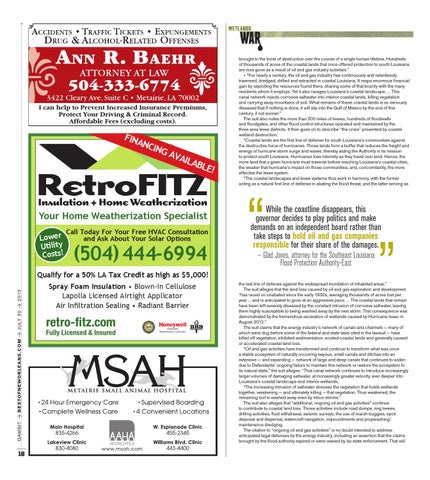RetroFITZ
Insulation + Home Weatherization Your Home Weatherization Specialist
GAMBIT > BESTOFNEWORLEANS.COM > JULY 30 > 2013
Lower Utility Costs!
18
Call Today For Your Free HVAC Consultation and Ask About Your Solar Options
(504) 444-6994
Qualify for a 50% LA Tax Credit as high as $5,000! Spray Foam Insulation • Blown-In Cellulose Lapolla Licensed Airtight Applicator
retro-fitz.com
Fully Licensed & Insured
Authorized Weatherization Contractor
“
“
FINA NCI NG AVA ILAB LE!
brought to the brink of destruction over the course of a single human lifetime. Hundreds of thousands of acres of the coastal lands that once offered protection to south Louisiana are now gone as a result of oil and gas industry activities.” • “For nearly a century, the oil and gas industry has continuously and relentlessly traversed, dredged, drilled and extracted in coastal Louisiana. It reaps enormous financial gain by exploiting the resources found there, sharing some of that bounty with the many residents whom it employs. Yet it also ravages Louisiana’s coastal landscape. … This canal network injects corrosive saltwater into interior coastal lands, killing vegetation and carrying away mountains of soil. What remains of these coastal lands is so seriously diseased that if nothing is done, it will slip into the Gulf of Mexico by the end of this century, if not sooner.” The suit also notes the more than 200 miles of levees, hundreds of floodwalls and floodgates, and other flood control structures operated and maintained by the three area levee districts. It then goes on to describe “the crisis” presented by coastal wetland destruction: “Coastal lands are the first line of defense for south Louisiana’s communities against the destructive force of hurricanes. Those lands form a buffer that reduces the height and energy of hurricane storm surge and waves, thereby aiding the Authority in its mission to protect south Louisiana. Hurricanes lose intensity as they travel over land. Hence, the more land that a given hurricane must traverse before reaching Louisiana’s coastal cities, the weaker that hurricane’s impact on those communities, and, concomitantly, the more effective the levee system. “The coastal landscapes and levee systems thus work in harmony, with the former acting as a natural first line of defense in abating the flood threat, and the latter serving as
While the coastline disappears, this governor decides to play politics and make demands on an independent board rather than take steps to hold oil and gas companies responsible for their share of the damages. — Glad Jones, attorney for the Southeast Louisiana Flood Protection Authority-East
the last line of defense against the widespread inundation of inhabited areas.” The suit alleges that the land loss caused by oil and gas exploration and development “has raced on unabated since the early 1930s, averaging thousands of acres lost per year … and is anticipated to grow at an aggressive pace. … The coastal lands that remain have been left severely diseased by the constant intrusion of corrosive saltwater, leaving them highly susceptible to being washed away by the next storm. This consequence was demonstrated by the tremendous excavation of wetlands caused by Hurricane Isaac in August 2012.” The suit claims that the energy industry’s network of canals and channels — many of which were dug before some of the federal and state laws cited in the lawsuit — have killed off vegetation, inhibited sedimentation, eroded coastal lands and generally caused or accelerated coastal land loss. “Oil and gas activities have transformed and continue to transform what was once a stable ecosystem of naturally occurring bayous, small canals and ditches into an extensive — and expanding — network of large and deep canals that continues to widen due to Defendants’ ongoing failure to maintain this network or restore the ecosystem to its natural state,” the suit alleges. “That canal network continues to introduce increasingly larger volumes of damaging saltwater, at increasingly greater velocity, ever deeper into Louisiana’s coastal landscape and interior wetlands. “The increasing intrusion of saltwater stresses the vegetation that holds wetlands together, weakening — and ultimately killing — that vegetation. Thus weakened, the remaining soil is washed away even by minor storms.” The suit also alleges that “additional, ongoing oil and gas activities” continue to contribute to coastal land loss. Those activities include road dumps, ring levees, drilling activities, fluid withdrawal, seismic surveys, the use of marsh buggies, spoil disposal and dispersal, watercraft navigation, impoundments and propwashing/ maintenance dredging. The citation to “ongoing oil and gas activities” is no doubt intended to address anticipated legal defenses by the energy industry, including an assertion that the claims brought by the flood authority expired or were waived by lax state enforcement. That will
